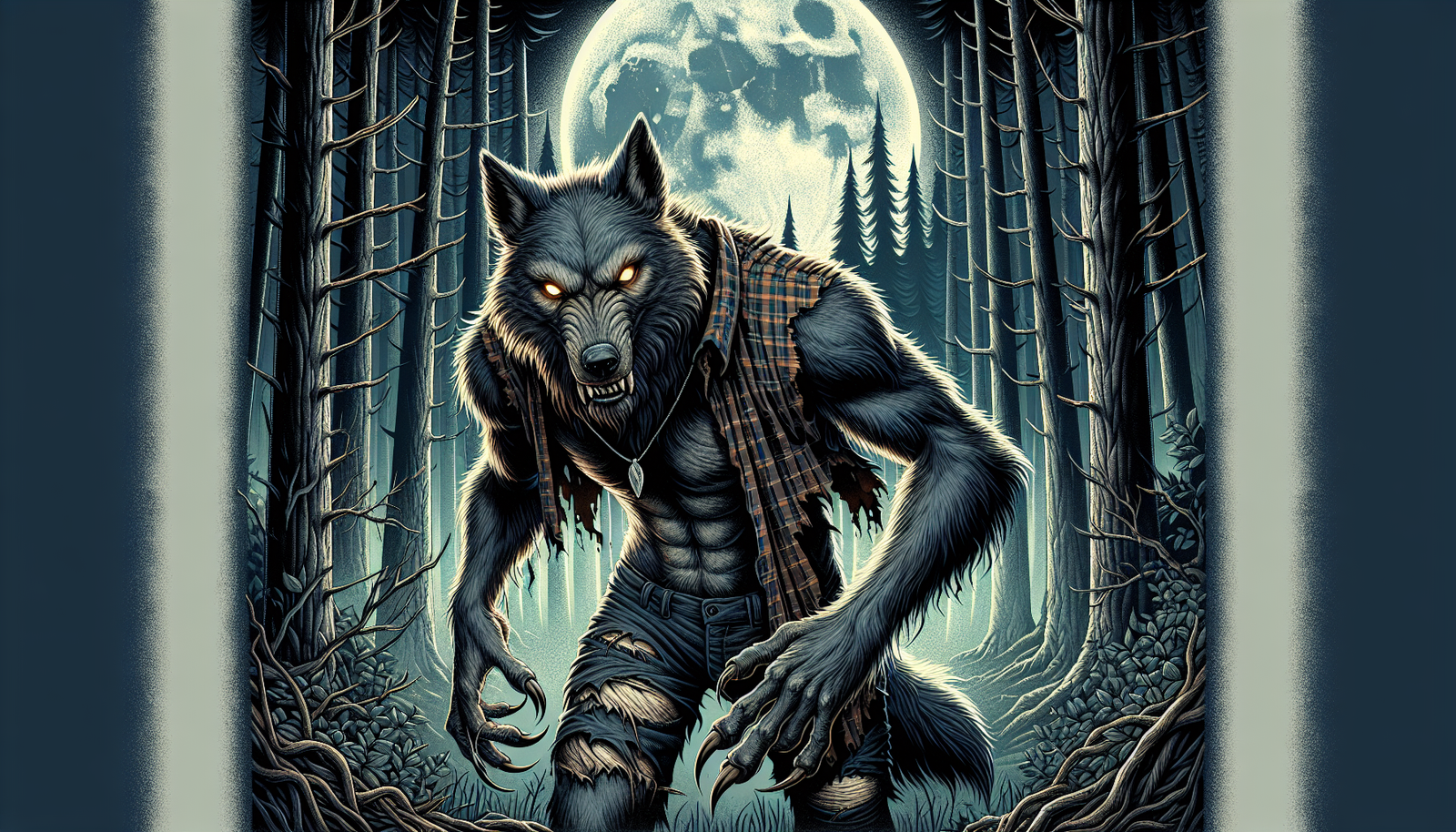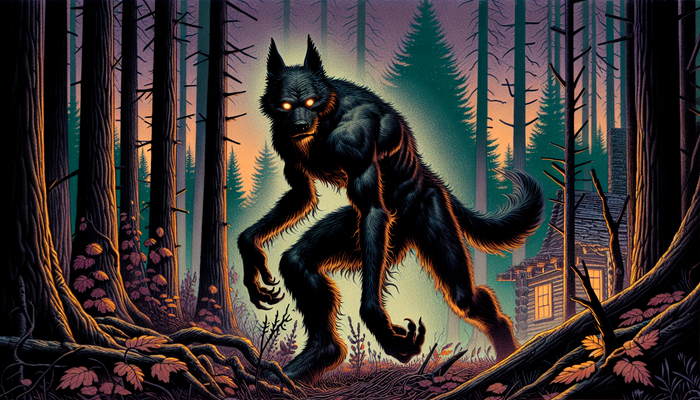The Bipedal Wolf: From Ancient Myth to Modern Sightings

By Anthony Romano, Cryptozoologist
Bipedal wolves, also known as werewolves or wolfmen, have captivated the human imagination for centuries. These mythical creatures, with their unnatural fusion of human and lupine traits, have stalked the shadowy corners of our collective psyche, appearing in the folklore, legends, and stories of cultures around the globe. From ancient Greek myths to medieval European tales, from Hollywood horror films to modern alleged sightings, the bipedal wolf has proven to be an enduring and fascinating figure.
But what is the origin of this fearsome beast? How has our conception of the werewolf evolved over time, from the literal shape-shifters of early legends to the iconic wolfmen of cinema? And what deeper psychological significance might these creatures hold, as reflections of our own primal nature and the blurred boundaries between man and animal?
In this article, we will embark on a journey through history, culture, and the human mind to explore the enduring allure of the bipedal wolf. We will trace the creature's roots in ancient mythology, examine its rise to prominence in popular culture, and investigate the startling real-world reports of upright canid creatures that continue to this day. Along the way, we will delve into the biological, psychological, and symbolic dimensions of the werewolf, seeking to understand why this fearsome beast continues to haunt and fascinate us.
So steel your nerves and sharpen your claws. The hunt for the truth behind the bipedal wolf is about to begin.
The Ancient Origins of the Bipedal Wolf Myth
The concept of a man transforming into a wolf dates back thousands of years, to the very dawn of human storytelling. One of the earliest known references comes from ancient Greek mythology, in the writings of the historian Herodotus. In the 5th century BCE, Herodotus described the Neuri, a tribe of nomads living in what is now Belarus and Ukraine. According to legend, the Neuri were sorcerers who transformed into wolves for several days each year.
Another famous Greek myth tells of King Lycaon, the cruel ruler of Arcadia. In one version of the tale, Lycaon sought to test the omniscience of the god Zeus by serving him human flesh at a banquet. Enraged by this impiety, Zeus transformed Lycaon into a ravenous wolf as punishment, dooming him to forever crave the flesh he had dared to feed the gods.
Interestingly, in these early Greek stories, the men who became wolves transformed into literal four-legged animals. The idea of a bipedal human-wolf hybrid, the classic werewolf as we know it today, would only emerge later in European folklore of the Middle Ages.
During this period, werewolves were often described as shape-shifters who straddled the line between the human and animal worlds. By day, they appeared as normal men and women, but under the light of the full moon, they transformed into savage beasts, half-man and half-wolf. These creatures were said to roam the countryside, ravaging livestock and hunting human prey.
Medieval folklore offered various methods for identifying a werewolf in its animal form. In some traditions, the beast could be recognized by its lack of a tail, a sure sign that it was no ordinary wolf. Other tales claimed that werewolves ran on three legs, using the fourth as a makeshift tail to complete the illusion of a natural animal. Some legends even held that the werewolf retained human eyes and a human voice, hinting at the intelligence lurking behind the bestial exterior.
While details varied across different cultures and regions, the fundamental idea of the werewolf remained consistent. This was a liminal being, a creature that blurred the boundaries between the civilized and the wild, the human and the animal. The werewolf embodied the fear that, beneath the veneer of our humanity, a primal beast lay waiting to break free.
The Rise of the Bipedal Wolf in Popular Culture
For centuries, the werewolf remained a creature of folklore and legend, haunting the imaginations of people across Europe and beyond. But in the early 20th century, the bipedal wolf would leap from the pages of myth into the realm of popular culture, thanks to the magic of Hollywood cinema.
The first mainstream werewolf movie, Werewolf of London, was released in 1935. This film introduced the concept of the wolfman as a tragic figure, a man cursed to transform into a beast against his will. The werewolf in this movie, played by Henry Hull, was depicted as a furry human-wolf hybrid, with a lupine head and clawed hands, but a body that remained largely human in shape. This marked a significant departure from the four-legged creatures of earlier folklore.
But it was 1941's The Wolf Man, starring Lon Chaney Jr. in the title role, that would truly establish the iconic image of the bipedal werewolf in the public consciousness. In this classic film, Chaney portrayed Larry Talbot, a man bitten by a werewolf and cursed to transform into a beast himself.
The Wolf Man's werewolf was a truly fearsome creature, a towering, hirsute beast with a wolf's head and razor-sharp claws. In the film's iconic transformation scenes, Talbot's face would twist and contort as fur sprouted from his skin, his teeth elongating into fangs, his hands curling into clawed paws. The resulting monster was a far cry from the literal wolves of ancient myth. This was a bipedal beast, a fusion of man and wolf that walked upright on two legs, clad in the tattered remnants of human clothing.
The Wolf Man was a massive success, and its depiction of the werewolf would go on to influence countless films, television shows, and novels in the decades that followed. The bipedal werewolf, with its human body and wolf's head, became the default image of the creature in popular culture. From the Howling series to An American Werewolf in London, from the lycanthropes of Underworld to the shape-shifters of Twilight, the basic template established by The Wolf Man has endured.
Of course, advances in special effects technology have allowed for increasingly sophisticated and convincing werewolf transformations over the years. The crude rubber masks and fur-covered gloves of The Wolf Man have given way to animatronics, prosthetics, and computer-generated imagery, enabling filmmakers to create ever more detailed and horrifying visions of the beast.
Yet despite these advancements, the fundamental image of the bipedal werewolf has remained largely unchanged. Even as our understanding of real wolves has grown, even as our fears and anxieties have evolved with the times, the half-man, half-wolf creature continues to stalk the realm of our nightmares. There is something primal and enduring about this fusion of human and animal, something that speaks to deep, dark corners of the psyche.
And as we shall see, the power of this image is not confined merely to the realm of fiction. For some, the bipedal wolf is more than just a figment of the imagination. It is a real and terrifying creature, one that may walk among us even now.
Real-World Sightings of Bipedal Wolf Creatures
While the bipedal wolf may have originated in myth and legend, there are those who believe that these creatures are more than just the stuff of folklore and Hollywood fantasy. For decades, eyewitness reports have surfaced of strange, upright canid creatures spotted in the wild, often in remote or heavily forested areas.
These alleged creatures are sometimes referred to as "dogmen," and they have been reported across the United States, from the dense woods of the Pacific Northwest to the swamps of the Deep South. Two of the most notable hotspots for dogman sightings are the states of Michigan and Kentucky.
In Michigan, tales of the "Michigan Dogman" have circulated since the 19th century. This creature is typically described as a large, bipedal canine, standing six to seven feet tall, with a powerful, muscular body covered in dark fur. Witnesses often report intelligent, almost human-like eyes, and a sense of malevolence or aggression emanating from the beast.
Kentucky, meanwhile, has become notorious for its high concentration of dogman sightings, particularly in and around the state's numerous parks and forests. In 2018, the Kentucky Department of Fish and Wildlife Resources allegedly received a staggering 887 reports of bipedal wolf creatures spotted by visitors to these natural areas.
These reports describe creatures very similar to the Michigan Dogman: tall, bipedal canines with wolf-like heads, covered in shaggy fur. Some witnesses claim to have seen the creatures running on all fours like normal wolves, only to rise up on their hind legs when startled or threatened. Others describe glowing, amber eyes that seem to reflect a keen intelligence, and a sense of being watched or stalked by an unseen predator.
Despite the volume and consistency of these reports, no conclusive physical evidence has yet been found to confirm the existence of dogmen or any similar creatures. Photographs and video footage of alleged dogmen invariably prove to be blurry, shaky, and inconclusive. Footprints and hair samples attributed to the creatures have been deemed inconclusive or outright hoaxes upon further analysis.
Skeptics argue that most dogman sightings can be attributed to misidentification of known animals, such as bears, wolves, or large dogs. They point out that eyewitness testimony is notoriously unreliable, and that memory can be easily distorted or influenced by preconceived notions and cultural expectations.
Yet for those who have encountered these creatures firsthand, the experience is all too real. They describe a profound sense of terror and awe in the presence of something that seems to defy explanation, a creature that blurs the line between the natural and the supernatural.
So what could these dogmen be, if they are indeed real? Theories abound, ranging from the plausible to the fantastical. Some suggest that they may be an undiscovered species of large, bipedal canine, perhaps a relic population of an extinct creature like the dire wolf. Others speculate that they could be the result of genetic mutations or environmental contamination, perhaps linked to the toxic effluent of industrial sites or government experiments gone awry.
More outlandish explanations delve into the realm of the paranormal and the extraterrestrial. Some researchers of the strange and unexplained have suggested that dogmen could be skinwalkers or shapeshifters, humans imbued with the mystical ability to transform into animal form at will. Others have proposed that they may be interdimensional entities, visitors from an alternate reality that somehow bleeds into our own.
A few intrepid theorists have even tried to connect dogman sightings to the enduring mystery of UFOs and alien visitation. Could these creatures be the product of extraterrestrial genetic manipulation, engineered by the same unknown entities responsible for crop circles and cattle mutilations? Might they even be aliens themselves, adopting the form of wolves to move among us undetected?
As outlandish as some of these ideas may seem, they speak to the profound sense of mystery and uncertainty that surrounds the dogman phenomenon. In the absence of hard evidence, the human mind rushes to fill in the gaps, to make sense of something that seems to defy rational explanation.
But as we shall see, the truth behind the bipedal wolf may be stranger than any fiction we can imagine. To unravel this mystery, we must delve deeper into the realms of science, psychology, and the very nature of our humanity.
The Biological Implausibility of Natural Bipedal Wolf Evolution
From a scientific standpoint, the idea of a naturally-evolved bipedal wolf is highly implausible, if not outright impossible. Wolves and humans are separated by millions of years of divergent evolution, and the anatomical changes required for a wolf to walk upright like a human are simply too vast to have occurred naturally within the timeframe of known history.
To understand why, we must consider the evolutionary history of both species. Wolves, like all members of the canine family, are descendants of a common ancestor that lived around 40 million years ago. This ancient progenitor was a small, fox-like creature that bore little resemblance to modern wolves or dogs.
Over millions of years, canines evolved and diversified, adapting to a wide range of ecological niches and environmental conditions. Some became specialized hunters, like wolves and coyotes, while others evolved into omnivorous scavengers, like jackals and foxes. But all of these species remained fundamentally four-legged, their anatomy honed for swift and efficient movement across the ground.
Humans, on the other hand, belong to the primate lineage, which diverged from other mammals around 85 million years ago. Our earliest ancestors were small, tree-dwelling creatures, more similar to modern lemurs or tarsiers than to any canine.
It wasn't until much later, around 7 million years ago, that the first hominins (human ancestors) began to diverge from other apes. These early hominins were still primarily quadrupedal, but over time, they began to develop adaptations for bipedal locomotion, such as a more upright posture, a curved lower spine, and a bowl-shaped pelvis.
The transition to full bipedalism was a gradual process that took millions of years. It required major changes to the skeleton and musculature, as well as significant alterations to the nervous system and sense of balance. Even our closest living relatives, chimpanzees and bonobos, are only partially bipedal, and their upright walking is far less efficient and stable than our own.
For a wolf to evolve bipedalism naturally, it would need to undergo a similar process of gradual adaptation over a very long period of time. This would require a consistent selective pressure favoring upright walking, such as a need to see over tall grass or to free up the forelimbs for tool use.
But wolves are already highly successful predators, superbly adapted for chasing down prey across open terrain. Their long, powerful legs, streamlined bodies, and keen senses make them swift and deadly hunters. There is no obvious evolutionary advantage to be gained by abandoning this tried-and-true body plan in favor of a bipedal stance.
Moreover, the anatomical changes required for bipedalism would likely be detrimental to a wolf's hunting ability. Upright walking requires a very different set of muscles and bones than quadrupedal running, and a wolf that tried to do both would likely be a master of neither.
Even if a population of wolves did somehow begin to evolve bipedalism, it would take hundreds of thousands, if not millions, of years for the necessary adaptations to become fixed in the population. The idea that such a process could have occurred in the mere tens of thousands of years since the last ice age, let alone the few centuries of recorded history, is simply not credible from a scientific standpoint.
Of course, this doesn't rule out the possibility of bipedal wolves being created through artificial means, such as genetic engineering. With sufficient technology and knowledge, it might be possible to modify a wolf's genome to induce bipedalism, or even to create a new species of upright canine from scratch.
But even in this scenario, the resulting creature would likely look very different from the bipedal werewolves of folklore and fiction. A genetically-engineered upright wolf would probably have a very different anatomy than a human, with digitigrade hind legs and a more crouched, forward-leaning posture.
It's unlikely that such a creature would have the perfectly human-like body and wolf's head of movie monsters
From Bigfoot to UFOs: Hangar 1 Publishing Has You Covered!
Explore Untold Stories: Venture into the world of UFOs, cryptids, Bigfoot, and beyond. Every story is a journey into the extraordinary.
Immersive Book Technology: Experience real videos, sights, and sounds within our books. Its not just reading; its an adventure.



























